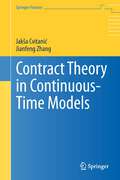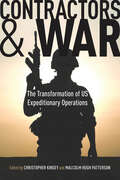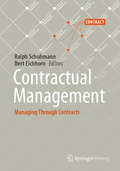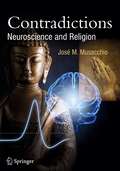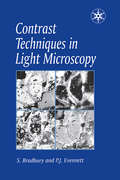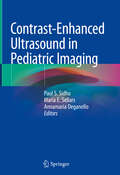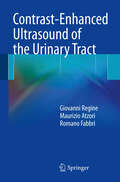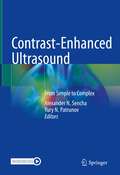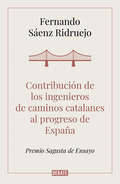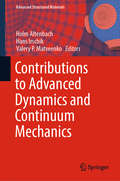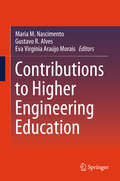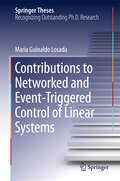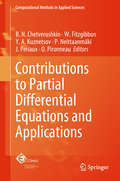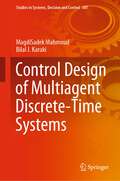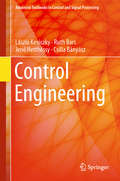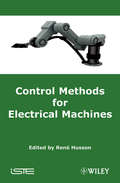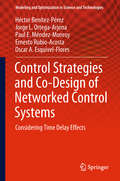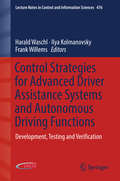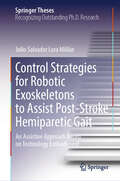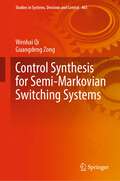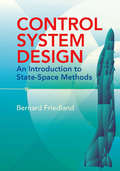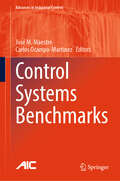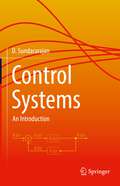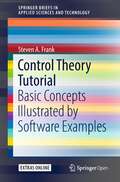- Table View
- List View
Contract Theory in Continuous-Time Models (Springer Finance)
by Jianfeng Zhang Jakša CvitanicIn recent years there has been a significant increase of interest in continuous-time Principal-Agent models, or contract theory, and their applications. Continuous-time models provide a powerful and elegant framework for solving stochastic optimization problems of finding the optimal contracts between two parties, under various assumptions on the information they have access to, and the effect they have on the underlying "profit/loss" values. This monograph surveys recent results of the theory in a systematic way, using the approach of the so-called Stochastic Maximum Principle, in models driven by Brownian Motion. Optimal contracts are characterized via a system of Forward-Backward Stochastic Differential Equations. In a number of interesting special cases these can be solved explicitly, enabling derivation of many qualitative economic conclusions.
Contractors and War: The Transformation of US Expeditionary Operations
by Christopher Kinsey Malcolm Hugh PattersonThe U. S. military is no longer based on a Cold War self-sufficient model. Today's armed forces are a third smaller than they were during the Cold War, and yet are expected to do as much if not more than they did during those years. As a result, a transformation is occurring in the way the U. S. government expects the military to conduct operations-with much of that transformation contingent on the use of contractors to deliver support to the armed forces during military campaigns and afterwards. Contractors and Warexplains the reasons behind this transformation and evaluates how the private sector will shape and be shaped by future operations. The authors are drawn from a range of policy, legislative, military, legal, and academic backgrounds. They lay out the philosophical arguments supporting the use of contractors in combat and stabilization operations and present a spectrum of arguments that support and criticize emergent private sector roles. The book provides fresh policy guidance to those who will research, direct, and carry out future deployments.
Contractual Management: Managing Through Contracts
by Bert Eichhorn Ralph SchuhmannThe Concept Contractual Management offers a holistic approach to managerial decision-making based on contracts or business processes that are related to contracts. It explains management from the point of view of the contract, just as it interprets the contract from the point of view of management. Thus, the approach highlights the great inherent potential of contracts for managing companies, transactions and business relationships. The book addresses students as well as practitioners and gives insights into the usage of contracts to manage companies or relationships. It covers contract handling from preliminary deliberations to negotiations, implementation, and all the way to the evaluation of the contract within the company. Furthermore, it provides competencies to design and implement a contract and to organize the relevant processes. The Content In Part 1, the book explains the theoretical foundations of Contractual Management; in Part 2, the application of the approach is illustrated through case studies which cover various sectors, industries, company sizes, contract types, and management situations. Theory part: Contractual Management – A Holistic Approach to a Diverse Issue. Case study part: 11 case studies arranged according to specific contract-related topics: Information and Communication – Change – Enterprise Networks – Conflict – Accounting and Financing – Legal Compliance – Societal Steering. The Editors Professor Dr. Ralph Schuhmann: After holding a senior management position in industry, Ralph Schuhmann now teaches Business Law at Ernst-Abbe-Hochschule in Jena, Germany. He is the scientific director of the Contractual Management Institute at SRH Hochschule Berlin and has published various articles on contract law and contract management. Professor Dr. Bert Eichhorn: Before his appointment as professor for International Law and Business Law at SRH Hochschule Berlin, Bert Eichhorn worked as a legal consultant at the EU Parliament and as a lawyer. He has published numerous articles in national and international scientific journals in the area of contract management and international law. He is the managing director of the Contractual Management Institute at SRH Hochschule Berlin.
Contradictions: Neuroscience and Religion (Springer Praxis Books)
by José M. Musacchio"Contradictions" is a general interest book that exposes the incompatibility between popular religious beliefs and the scientific view of human nature. It begins with a survey of the evolution of religions and their continuing, often irrational, influences in modern society. Then, based on his long experience in neuroscience, the author takes issue with Decartes about the duality of body and soul. He presents case studies of patients with brain diseases and from these deduces that the soul, far from being separate and supernatural, is no more or less than our way of experiencing our brains ... and which correspondingly disintegrates when they do. Convincing clinical findings and powerful arguments about the universality of truth make this book a bold contribution to the debate about belief and religion in the modern world.
Contrast Techniques in Light Microscopy
by S. Bradbury and P.J. EvennettContrast in an image is essential to distinguish features from one another and from the background. This practical handbook describes the ways in which light interacts with the specimen in the microscope.
Contrast-Enhanced Ultrasound in Pediatric Imaging
by Paul S. Sidhu Maria E. Sellars Annamaria DeganelloThis book is a comprehensive guide to the rapidly evolving field of contrast-enhanced ultrasound (CEUS) in the child. The uses and interpretation of CEUS are clearly explained with the aid of numerous illustrations. The coverage encompasses both established indications, such as focal liver lesions, abdominal solid organ injury, and vesicoureteral reflux, and a range of newer applications. Extensive information is also provided on microbubble agents and their use in the pediatric age group, as well as on practical aspects of setting up a CEUS service for children.CEUS is a safe imaging method that is ideal for the young patient and can be used for problem solving in a number of clinical situations. Ultrasound combined with microbubble contrast avoids the ionizing radiation of a CT examination, the use of iodinated contrast, the need for sedation or a general anesthetic, and the complexities of MR imaging. In bringing readers up to date with best practice and the latest innovations in CEUS, this book will be of value for pediatric radiologists, pediatric sonographers/technicians, and pediatricians.
Contrast-Enhanced Ultrasound of the Urinary Tract
by Maurizio Atzori Giovanni Regine Romano FabbriThis book examines in detail the diagnostic impact of contrast-enhanced ultrasound in the evaluation of urinary tract pathology, paying particular attention to the diagnostic gain that may be expected in relation to other imaging techniques such as CT and MRI. The role of contrast-enhanced ultrasound is evaluated in a range of pathologies, including ischemia, trauma, inflammation, cystic lesions, and solid tumors, as well as in the imaging of anatomic variants. New applications, for example monitoring of kidney transplantation, assessment of urinary bladder lesions, and diagnosis of vesico-ureteric reflux, are also covered. The presented cases, drawn from the authors' personal clinical caseload, include images obtained using multimodality techniques, sometimes with 3D CT reconstruction. The authors' own experiences are compared with the most recent reports in the scientific literature.
Contrast-Enhanced Ultrasound: From Simple to Complex
by Alexander N. Sencha Yury N. PatrunovThis book provides a comprehensive analysis of the value of contrast-enhanced ultrasound (CEUS) in the diagnosis of a wide variety of pathologies. Sonography reliably identifies a wide range of diseases, and the efficacy of modern ultrasound has dramatically improved with contrast enhancement. This book covers almost all aspects of CEUS starting from basic principles and ending with features of its application in individual organs. In particular, it explores the diseases of abdominal, retroperitoneal, and pelvic organs as well as superficial structures, highlighting the characteristic features of typical findings. Focal lesions are discussed in depth, with attention to their early detection and differential diagnosis. Besides, a practical approach to the stratification of the risk of malignancies is provided. The authors summarized their own experience with CEUS in oncology, hepatology, gynecology, urology, endocrinology, and other fields of medicine. The role of CEUS in differential diagnosis of various disorders of the female reproductive system is comprehensively discussed as well. The presentation is clear and concise, and richly illustrated. The book will be a helpful tool for both residents and practitioners approaching ultrasound diagnostics, as well for more experienced radiologists and other professionals.
Contribución de los ingenieros de caminos catalanes al progreso de España
by Fernando Sáenz RidruejoEste libro atesora algunas de las aportaciones más importantes a la Ingeniería de Caminos de nuestro país y da a conocer a sus geniales artífices. «Las obras públicas son realidades muy complejas que pueden determinar la prosperidad o la ruina de comarcas enteras.» Las palabras de Sáenz Ridruejo quedan reflejadas en este elaborado compendio biográfico del que emana un gran respeto por la profesión y por los compañeros con quienes la comparte. Fruto de una rigurosa investigación, este libro llega de la mano del historiador de los ingenieros de Caminos por excelencia y aporta un detallado testimonio de las contribuciones catalanas al progreso de la casa y de la causa común, ingenios que han facilitado y que facilitan a diario nuestra movilidad, nuestra comodidad y, en definitiva, nuestras vidas.
Contributions of Chemical Engineering to Sustainability
by Juan Gabriel Segovia-Hernández Nelly Ramírez-Corona Valentina Aristizábal-MarulandaThis book discusses the recent advancements in chemical engineering and their role in achieving the United Nations' 2030 Agenda and Sustainable Development Goals (SDGs). Addressing these goals involves tackling intricate and interdisciplinary challenges.Chemical engineers have been diligently addressing a diverse array of issues across academia, society, and industry, with the aim of positively impacting these goals.The book offers essential insights and detailed analyses for each SDG. It explores the challenges encountered within various applications and proposes solutions based on foundational engineering principles. The book's content is tailored to professionals, students, and researchers across diverse fields, including engineering, environmental science, and biotechnology.
Contributions to Advanced Dynamics and Continuum Mechanics (Advanced Structured Materials #114)
by Holm Altenbach Hans Irschik Valery P. MatveenkoThe book celebrates the 65th birthday of Prof. Alexander K. Belyaev—a well-known expert in the field of Dynamics of Mechanical Systems. In addition to reflecting Prof. Belyaev’s contributions, the papers gathered here address a range of current problems in Dynamics and Continuum Mechanics. All contributions were prepared by his friends and colleagues, and chiefly focus on theory and applications.
Contributions to Higher Engineering Education
by Maria M. Nascimento Gustavo R. Alves Eva Virgínia Araújo MoraisThe book focuses on teaching knowledge and principles (Higher Education) regarding professional practice of engineering (life and lifelong learning). It covers recent developments in engineering education. This book comprises the select proceedings of the conference organised by the Portuguese Society for Engineering Education. This book goes beyond the examination of the economic, culture, and social factors, which influence the education of engineers in different higher education institutions, and encompasses critical thinking and problem solving, communication, collaboration and creativity and innovation. These are essential components of engineering education. The contents of this book are useful to researchers and professionals engaged in the re-engineering of engineering education.
Contributions to Networked and Event-Triggered Control of Linear Systems (Springer Theses)
by María Guinaldo LosadaThis book reports on a set of new techniques for resolving current issues in networked control systems. The main focus is on strategies for event-based control, for both centralized and decentralized architectures. The first part of the book addresses the problem of single-loop networked control systems and proposes an anticipative remote controller for dealing with delays and packet losses. The second part of the book proposes a distributed event-based control strategy for networked dynamical systems, which has been implemented in a test-bed of mobile robots, and provides readers with a thorough description of an interactive simulator used to validate the results. This thesis, examined at the Universidad Nacional de Educación a Distancia in 2013, received the award for best thesis in control engineering from the Control Engineering group of the Spanish Committee of Automatic Control in 2015.
Contributions to Partial Differential Equations and Applications (Computational Methods in Applied Sciences #47)
by B. N. Chetverushkin W. Fitzgibbon Y. A. Kuznetsov P. Neittaanmäki J. Periaux O. PironneauThis book treats Modelling of CFD problems, Numerical tools for PDE, and Scientific Computing and Systems of ODE for Epidemiology, topics that are closely related to the scientific activities and interests of Prof. William Fitzgibbon, Prof. Yuri Kuznetsov, and Prof. O. Pironneau, whose outstanding achievements are recognised in this volume. It contains 20 contributions from leading scientists in applied mathematics dealing with partial differential equations and their applications to engineering, ab-initio chemistry and life sciences. It includes the mathematical and numerical contributions to PDE for applications presented at the ECCOMAS thematic conference "Contributions to PDE for Applications" held at Laboratoire Jacques Louis Lions in Paris, France, August 31- September 1, 2015, and at the Department of Mathematics, University of Houston, Texas, USA, February 26-27, 2016. This event brought together specialists from universities and research institutions who are developing or applying numerical PDE or ODE methods with an emphasis on industrial and societal applications. This volume is of interest to researchers and practitioners as well as advanced students or engineers in applied and computational mathematics. All contributions are written at an advanced scientific level with no effort made by the editors to make this volume self-contained. It is assumed that the reader is a specialist already who knows the basis of this field of research and has the capability of understanding and appreciating the latest developments in this field.
Control Design of Multiagent Discrete-Time Systems (Studies in Systems, Decision and Control #387)
by MagdiSadek Mahmoud Bilal J. KarakiThis book describes an effective approach to the cooperative and coordinated control of multivehicle systems. This rigorous analytic approach guarantees the stability of coordinated and cooperating vehicles using distributed protocols and uses low-energy, event-triggered mechanisms for networked vehicle control. The text covers: design of a cooperative protocol to achieve consensus for multivehicle systems, allowing cooperation that is resistant to the effects of packet loss and/or adversarial attack; analysis and synthesis of an event-triggering mechanism for cooperative multivehicle systems over uncertain networks; and the problem of distributed leader-following consensus and methods for compelling multivehicle systems to reach consensus. Throughout the book, cooperation problems are transformed into stability problems. Lyapunov theory is used to guarantee cooperation among agents. The distributed approach is applied to triggering mechanisms, the cooperation process, and the impact of cyber-attacks. Discrete-time analysis shows how the event-based structure can be designed to match the performance of continuous-time counterparts. The book details applications and computer simulation with several practical examples. This book is of interest to a wide audience from the graduate student, through the academic researcher to the industrial practitioner, all of them sharing a common interest in the stability and security of multiagent systems.
Control Engineering: From The Basics To The Applications (Advanced Textbooks in Control and Signal Processing)
by Ruth Bars László Keviczky Jenő Hetthéssy Csilla BányászThis book offers fundamental information on the analysis and synthesis of continuous and sampled data control systems. It includes all the required preliminary materials (from mathematics, signals and systems) that are needed in order to understand control theory, so readers do not have to turn to other textbooks. Sampled data systems have recently gained increasing importance, as they provide the basis for the analysis and design of computer-controlled systems. Though the book mainly focuses on linear systems, input/output approaches and state space descriptions are also provided. Control structures such as feedback, feed forward, internal model control, state feedback control, and the Youla parameterization approach are discussed, while a closing section outlines advanced areas of control theory. Though the book also contains selected examples, a related exercise book provides Matlab/Simulink exercises for all topics discussed in the textbook, helping readers to understand the theory and apply it in order to solve control problems. Thanks to this combination, readers will gain a basic grasp of systems and control, and be able to analyze and design continuous and discrete control systems.
Control Methods for Electrical Machines
by René HussonThe type of control system used for electrical machines depends on the use (nature of the load, operating states, etc.) to which the machine will be put. The precise type of use determines the control laws which apply. Mechanics are also very important because they affect performance. Another factor of essential importance in industrial applications is operating safety. Finally, the problem of how to control a number of different machines, whose interactions and outputs must be coordinated, is addressed and solutions are presented. These and other issues are addressed here by a range of expert contributors, each of whom are specialists in their particular field. This book is primarily aimed at those involved in complex systems design, but engineers in a range of related fields such as electrical engineering, instrumentation and control, and industrial engineering, will also find this a useful source of information.
Control Strategies and Co-Design of Networked Control Systems: Considering Time Delay Effects (Modeling and Optimization in Science and Technologies #13)
by Héctor Benítez-Pérez Jorge L. Ortega-Arjona Paul E. Méndez-Monroy Ernesto Rubio-Acosta Oscar A. Esquivel-FloresThis book presents Networked Control System (NCS) as a particular kind of a real-time distributed system (RTDS), composed of a set of nodes, interconnected by a network, and able to develop a complete control process. It describes important parts of the control process such as sensor and actuator activities, which rely on a real-time operating system, and a real-time communication network. As the use of common bus network architecture introduces different forms of uncertainties between sensors, actuators, and controllers, several approaches such as reconfigurable systems have been developed to tackle this problem. Moreover, modeling NCS is a challenging procedure, since there are several non-linear situations, like local saturations, uncertain time delays, dead-zones, or local situations, it is necessary to deal with. The book describes a novel strategy for modelling and control based on a fuzzy control approach and codesign strategies.
Control Strategies for Advanced Driver Assistance Systems and Autonomous Driving Functions: Development, Testing and Verification (Lecture Notes in Control and Information Sciences #476)
by Harald Waschl Ilya Kolmanovsky Frank WillemsThis book describes different methods that are relevant to the development and testing of control algorithms for advanced driver assistance systems (ADAS) and automated driving functions (ADF). These control algorithms need to respond safely, reliably and optimally in varying operating conditions. Also, vehicles have to comply with safety and emission legislation. The text describes how such control algorithms can be developed, tested and verified for use in real-world driving situations. Owing to the complex interaction of vehicles with the environment and different traffic participants, an almost infinite number of possible scenarios and situations that need to be considered may exist. The book explains new methods to address this complexity, with reference to human interaction modelling, various theoretical approaches to the definition of real-world scenarios, and with practically-oriented examples and contributions, to ensure efficient development and testing of ADAS and ADF. Control Strategies for Advanced Driver Assistance Systems and Autonomous Driving Functions is a collection of articles by international experts in the field representing theoretical and application-based points of view. As such, the methods and examples demonstrated in the book will be a valuable source of information for academic and industrial researchers, as well as for automotive companies and suppliers.
Control Strategies for Robotic Exoskeletons to Assist Post-Stroke Hemiparetic Gait: An Assistive Approach Based on Technology Embodiment (Springer Theses)
by Julio Salvador Lora MillánThis book presents a new framework to improve the integration of exoskeletons in hemiparetic patients. The idea is to reduce potentially damaging compensatory strategies in the non-paretic leg, by ensuring a proper technology embodiment of the robotic exoskeletons in the nervous system. Upon reviewing control strategies for partial robotic exoskeletons applied to human gait, the book introduces robotic exoskeletons control algorithms, which were developed with the intention to promote gait symmetry by assisting the affected limb of hemiparetic patients according to the movement of the non-paretic leg. This new paradigm aimed at promoting the device's embodiment was expected to counteract the compensation mechanisms, which would become unnecessary and thus disappear. The control strategy relies on the gait phase estimation of the sound leg calculated using an adaptive frequency oscillator and was evaluated on post-stroke patients affected by hemiparetic gait, and the results are described in this book. All in all, this book offers a timely snapshot on control strategies for post-stroke robotic gait assistance. It also presents new findings concerning the role of robotic controllers in the embodiment of such devices, and their implications for new assistance paradigms for people with neurological gait disorders.
Control Synthesis for Semi-Markovian Switching Systems (Studies in Systems, Decision and Control #465)
by Wenhai Qi Guangdeng ZongThe book focuses on control synthesis for semi-Markovian switching systems. By using multiple semi-Markovian Lyapunov function approaches, a basic theoretical framework is formed toward the issue of control synthesis for semi-Markovian switching systems. This is achieved by providing an in-depth study on several major topics such as sliding mode control, finite-time control, quantized control, event-triggered control, synchronization, and fuzzy control for semi-Markovian switching systems. The comprehensive and systematic treatment of semi-Markovian switching systems is one of the major features of the book, which is particularly suitable for readers who are interested to learn control theory and engineering. By reading this book, the reader can obtain the most advanced analysis and design techniques for stochastic switching systems.
Control System Design: An Introduction to State-Space Methods (Dover Books on Electrical Engineering)
by Bernard FriedlandAddressed not only to students but also to professional engineers and scientists, this volume introduces state-space methods for direct applications to control system design, in addition to providing background for reading the periodical literature. Its presentation, therefore, is suitable both for those who require methods for achieving results and those more interested in using results than in proving them.Topics include feedback control; state-space representation of dynamic systems and dynamics of linear systems; frequency-domain analysis; controllability and observability; and shaping the dynamic response. Additional subjects encompass linear observers; compensator design by the separation principle; linear, quadratic optimum control; random processes; and Kalman filters.Concrete examples of how state-space methods can be used to advantage in several representative applications are woven into the fabric of the text and the homework problems. Many of the models are drawn from aerospace and inertial instrumentation; other examples are derived from chemical process control, maritime operations, robotics, and energy systems.
Control Systems Benchmarks (Advances in Industrial Control)
by José M. Maestre Carlos Ocampo-MartinezControl Systems Benchmarks helps control engineers, researchers, and students to evaluate and compare control system performance across a range of critical applications by offering a collection of real-world benchmarks. The book brings together challenges from diverse fields like power grids, robotics, automotive systems, and industrial processes, giving readers practical tools to test their control methods in realistic settings. Organized into two blocks, the book first tackles process control, covering dynamic and large-scale problems such as load-frequency control in power grids and wastewater-treatment-plant automation. The second block explores robotics and vehicles, focusing on areas like fault-tolerant control of quadrotors and lateral stability in electric vehicles. Each benchmark presents complex engineering challenges, allowing readers to experiment with various control approaches. This book is set apart by the consistent structure of its chapters, which enables readers to adapt benchmarks for their own systems easily. Each chapter includes: a brief overview of the benchmark, highlighting its significance and technical hurdles; a detailed problem description, including engineering goals and constraints; experimental setup, performance metrics, and data collection methods; downloadable materials and instructions for running simulations or accessing physical platforms; and a discussion of existing solutions, case studies, and open challenges to inspire further research. Whether you're a practitioner, an academic researcher, or a student eager to deepen your understanding of control systems, Control Systems Benchmarks offers practical insights and valuable resources to advance your work.
Control Systems: An Introduction
by Dr. D. SundararajanThis textbook is designed for an introductory, one-semester course in Control Systems for undergraduates and graduates in various engineering departments, such as electrical, mechanical, aerospace, and civil. It is written to be concise, clear, and yet comprehensive to make it easier for the students to learn this important subject with high mathematical complexity. The author emphasizes the physical simulation of systems, making it easier for readers to understand system behavior. The popular MATLAB® software package is used for programming and simulation. Every new concept is explained with figures and examples for a clear understanding. The simple and clear style of presentation, along with comprehensive coverage, enables students to obtain a solid foundation in the subject and for use in practical applications.
Control Theory Tutorial: Basic Concepts Illustrated by Software Examples (SpringerBriefs in Applied Sciences and Technology)
by Steven A. FrankThis open access Brief introduces the basic principles of control theory in a concise self-study guide. It complements the classic texts by emphasizing the simple conceptual unity of the subject. A novice can quickly see how and why the different parts fit together. The concepts build slowly and naturally one after another, until the reader soon has a view of the whole. Each concept is illustrated by detailed examples and graphics. The full software code for each example is available, providing the basis for experimenting with various assumptions, learning how to write programs for control analysis, and setting the stage for future research projects. The topics focus on robustness, design trade-offs, and optimality. Most of the book develops classical linear theory. The last part of the book considers robustness with respect to nonlinearity and explicitly nonlinear extensions, as well as advanced topics such as adaptive control and model predictive control. New students, as well as scientists from other backgrounds who want a concise and easy-to-grasp coverage of control theory, will benefit from the emphasis on concepts and broad understanding of the various approaches.
